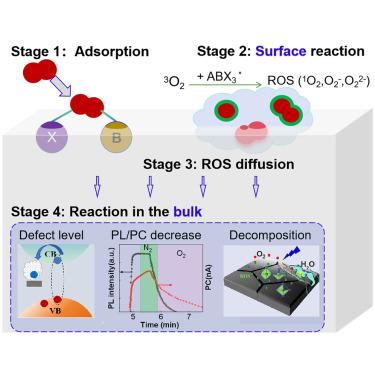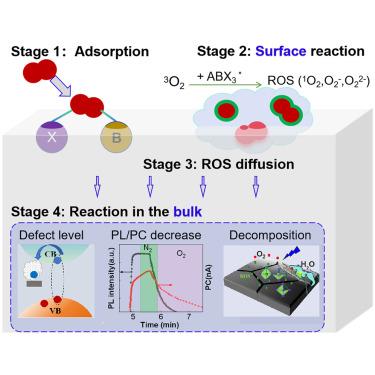The interactions between halide perovskites and oxygen: From stages to strategies
IF 17.3
1区 材料科学
Q1 MATERIALS SCIENCE, MULTIDISCIPLINARY
引用次数: 0
Abstract
Metal halide perovskites (MHPs) face stability challenges particularly due to their susceptibility to oxygen exposure, hindering their practical applications. Unraveling the complicated photophysical and photochemical behaviors of MHPs in the presence of oxygen is essential to overcome this obstacle. To address this critical issue, we aim to integrate the recent findings and elucidate the dynamics of perovskite-oxygen interactions. The interactions between MHPs and oxygen are clarified in four fundamental stages: adsorption on the surface, surface reactions, diffusion of reactive oxygen species (1O2, O2−, O22−), and bulk reactions. We try to provide a comprehensive and nuanced understanding of these interactions, emphasizing the underlying mechanisms governing charge and energy transfers. Within this framework, we particularly discuss the pronounced vulnerability of tin (Sn)-based perovskites to oxygen and analyze the distinct factors that amplify this susceptibility. Following this, we summarize the impact of oxygen exposure on the photoelectric performance of MHPs and outline potential strategies to mitigate superoxide-mediated degradation pathways. Gaining a deeper understanding of the perovskite-oxygen interaction can offer valuable insights for material optimization and device design, ultimately enhancing stability against oxygen exposure.


卤化物过氧化物与氧气之间的相互作用:从阶段到战略
金属卤化物过氧化物(MHPs)面临着稳定性方面的挑战,特别是由于它们容易受到氧气的影响,从而阻碍了它们的实际应用。要克服这一障碍,就必须揭示 MHPs 在氧气存在下复杂的光物理和光化学行为。为了解决这一关键问题,我们旨在整合近期的研究成果,阐明包晶与氧相互作用的动力学。我们从四个基本阶段阐明了 MHP 与氧的相互作用:表面吸附、表面反应、活性氧(1O2、O2-、O22-)的扩散以及块体反应。我们试图提供对这些相互作用的全面而细致的理解,强调电荷和能量转移的基本机制。在这一框架内,我们特别讨论了锡(Sn)基过氧化物对氧气的明显脆弱性,并分析了放大这种易感性的不同因素。随后,我们总结了氧气暴露对 MHP 光电性能的影响,并概述了减轻超氧化物介导的降解途径的潜在策略。更深入地了解包晶石与氧的相互作用,可以为材料优化和器件设计提供宝贵的见解,最终提高抗氧暴露的稳定性。
本文章由计算机程序翻译,如有差异,请以英文原文为准。
求助全文
约1分钟内获得全文
求助全文
来源期刊

Matter
MATERIALS SCIENCE, MULTIDISCIPLINARY-
CiteScore
26.30
自引率
2.60%
发文量
367
期刊介绍:
Matter, a monthly journal affiliated with Cell, spans the broad field of materials science from nano to macro levels,covering fundamentals to applications. Embracing groundbreaking technologies,it includes full-length research articles,reviews, perspectives,previews, opinions, personnel stories, and general editorial content.
Matter aims to be the primary resource for researchers in academia and industry, inspiring the next generation of materials scientists.
 求助内容:
求助内容: 应助结果提醒方式:
应助结果提醒方式:


